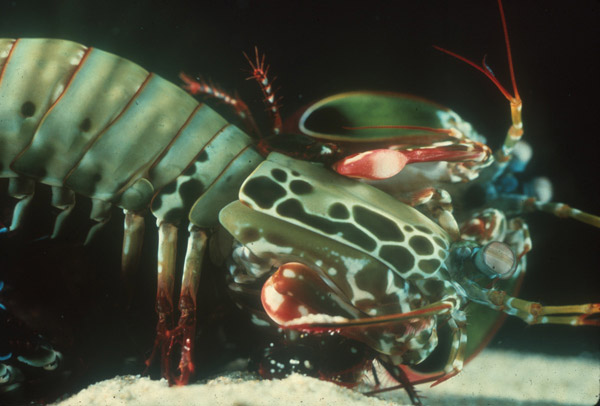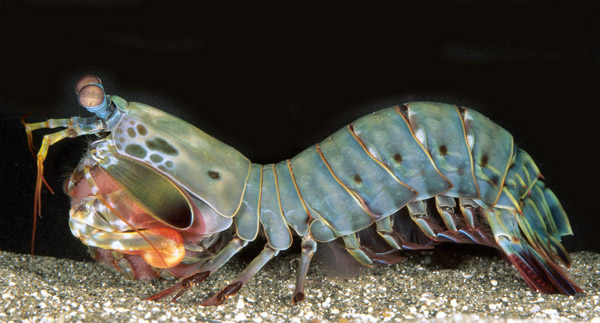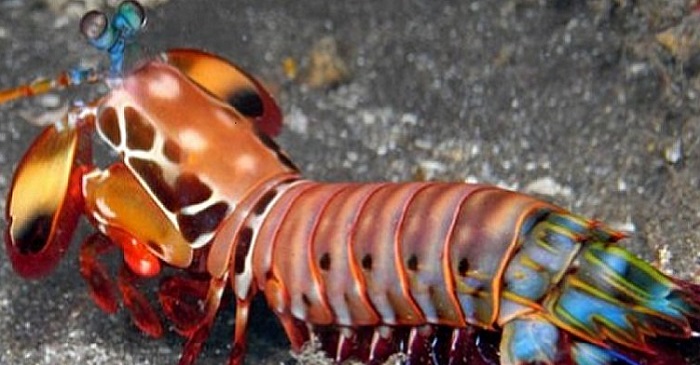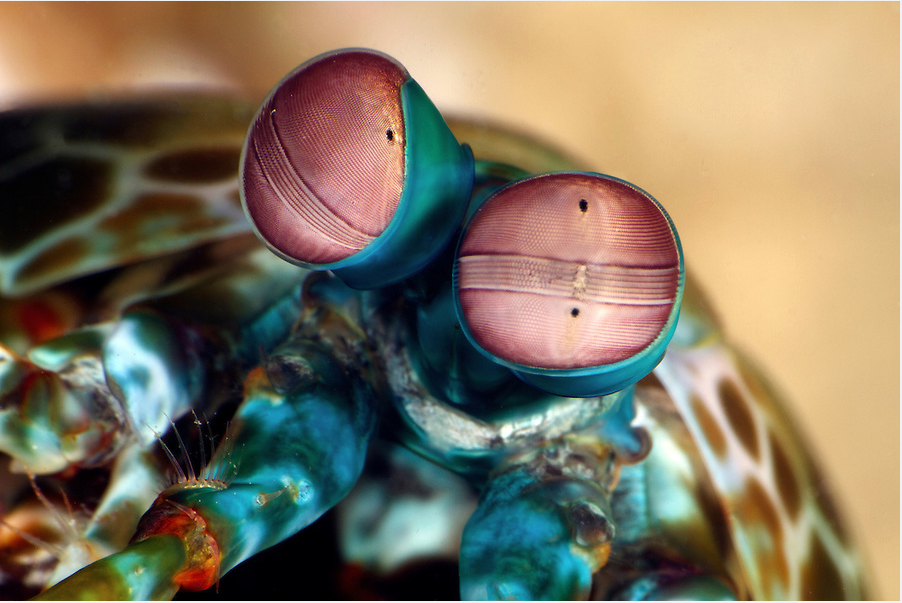Secret Weapons Exposed
The peacock mantis shrimp is a very beautiful looking,
interesting individual with many complex features that make it
unique from other organisms. Just to mention a few things, they
have very complex eyes that can see ultraviolet light, and a
very powerful defense mechanism adapted for their environment.
The peacock
mantis shrimp is a beautiful creature to say the least. It has a
vast array of colors throughout its body.
 Their main part of the
body or base, is a green/olive color. Its antennae is made up of
brightly colored orange scales, and it has appendages that are a
beautiful red color. They also have a pattern similar to a
leopard that covers their lower carapace. The eyes have a blue
color to them as well (Chui 2013). The reason why they are so
colorful is for mating purposes. The colors on the body are
transmitted in wavelengths that can be detected by the mantis
shrimp. They also use their florescent colors to send visual
warning signals to the predators in their habitat (Mesa 2013).
Their main part of the
body or base, is a green/olive color. Its antennae is made up of
brightly colored orange scales, and it has appendages that are a
beautiful red color. They also have a pattern similar to a
leopard that covers their lower carapace. The eyes have a blue
color to them as well (Chui 2013). The reason why they are so
colorful is for mating purposes. The colors on the body are
transmitted in wavelengths that can be detected by the mantis
shrimp. They also use their florescent colors to send visual
warning signals to the predators in their habitat (Mesa 2013).
The average
mantis shrimp measures anywhere between about 3-18 cm but have
been known to measure up to 38 cm in some rare cases (Chui 2013,
Mesa 2013). The mantis shrimp have a carapace that covers
the lower half of the head that leaves a small area open for the
eyes. They also have raptorial appendages, a single pair of
maxillopods, as well as three sets of legs for walking, and 5
pairs of legs. These legs help the peacock mantis shrimp with
moving around, swimming, and help them with excavating their
dens (Chui 2013).
One of the
few features that makes the Peacock mantis shrimp very unique is
its very advanced pair of eyes it has adapted for life on the
coral reef. They are known to have some of the most advanced
eyes in the animal kingdom, having around 12-16 different
photoreceptors types in their eyes. These sample a small set of
perceivable wavelengths ranging anywhere from very ultraviolet
rays to far red colors. Most animals only use around 3 or 4 to
accurately discriminate colors. The reason why stomatopods, like
the peacock mantis shrimp use 12 photoreceptors is because it
would “allow for extremely rapid color recognition without the
need to discriminate between wavelengths within a spectrum”
(Hanne et al. 2014, Rose 2009). They need these special eyes
because the live in shallow coral reefs, one of the most
colorful environments in the world, and scientists believe that
their complexly colored bodies are involved in a complex
communication system. They use their bodies and vibrant colors
to communicate with predators to warn them. The females also use
their bodies to communicate with the males to tell them when the
best time to mate is by reading the moon for tidal cycles (Mesa
2013). By reading the tidal cycles, they can figure out when the
best times to mate are so then the males don't waste their
efforts. They also use this special vision to help the
make quick, accurate color signal judgments under conditions
with changing light about predators, prey, and just other
information about their surroundings that aid in survival
(Hanne et al. 2014).
Another
interesting structure that the peacock mantis shrimp possesses
is its club like defense mechanism. They have a raptorial
appendages that are in the shape of a small club. These small
clubs can reach speeds of 23 meters per second and can
accelerate around 10,400 g. Scientists have recorded impact
forces ranging from 400-1500 N. Due to such fast movement, the
cause cavitation bubbles to form which bombard their
enemies/prey with and additional force of up to 504 N (Rose
2009). The cavitation bubbles can produce light and heat that
can reach up to several thousand Kelvin and produce a intense
snapping sound. With such force the Peacock mantis sharp can
crush shells of prey and have been known to break tanks in
aquariums.
How does this
mechanism work? Well there are structures that are called
sclerites that when engaged, keep the club/hammer appendage in
place. The contain a saddle like structure located near the top
of the appendage that is really flexible and is important in the
reduction of the bucking during the striking motion, and adds
10% of stored energy to the limb. The majority of the other
energy is stored in a structure called the “meral-V” which is
next to the saddle which functions as the spring where energy is
stored without causing harm the mantis shrimp. Then when it
wants to attack it disengages the latches and all the other
structures collectively, and all the built up energy is released
causing a large amount of force to be generated to attack either
prey, or predators (Rose 2009). The pair of raptorial appendages
they have help keep predators near the coral reefs in check and
aid them in fighting and feeding on prey such as snails, clams, and crabs
such as the red rock crab (C.
productus).
The contain a saddle like structure located near the top
of the appendage that is really flexible and is important in the
reduction of the bucking during the striking motion, and adds
10% of stored energy to the limb. The majority of the other
energy is stored in a structure called the “meral-V” which is
next to the saddle which functions as the spring where energy is
stored without causing harm the mantis shrimp. Then when it
wants to attack it disengages the latches and all the other
structures collectively, and all the built up energy is released
causing a large amount of force to be generated to attack either
prey, or predators (Rose 2009). The pair of raptorial appendages
they have help keep predators near the coral reefs in check and
aid them in fighting and feeding on prey such as snails, clams, and crabs
such as the red rock crab (C.
productus).
Next to
Reproduction
Back to Home

